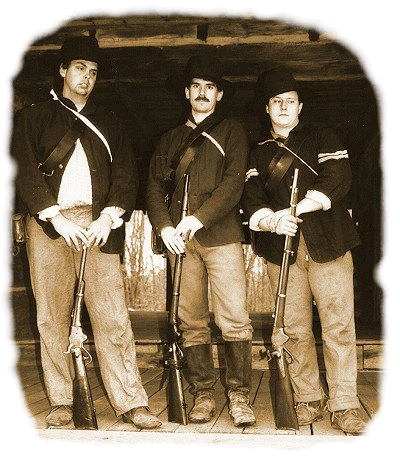
Wilder's Brigade Mounted Infantry
††††††††††††††† Living History Society

Equipment
For a listing of equipment suppliers, please see the vendor list.
†
Mounts
Horses or mules are acceptable. Most of the mounts of the brigade were captured, so a wide variety of mounts is appropriate (well except for camels, llamas and emuís). Horse breeds that are blatantly not period should be avoided (i.e. paints).
UniformUniform Jacket
Federal Issue sack coat or untrimmed mounted service shell jacket of
correct and appropriate materials and pattern. All buttonholes should be
hand sewn and if applicable, all top stitching should be hand sewn as
well.
Uniform Trousers
Federal issue infantry or mounted pattern of correct and appropriate
materials and pattern. All buttonholes should be hand sewn and if
applicable, all top stitching should be hand sewn as well. The pants
should have no trim whatsoever.
Headgear
Untrimmed and undecorated (i.e. no hat brass) 1858 Hardee hat or civilian
slouch hat of correct and appropriate patterns. Kepiís will be allowed,
but are discouraged. Absolutely no cowboy or oddball hats. Stampede
strings (chin strings) are heavily discouraged for reenactments and not
allowed for living histories.
Drawers
Pair of issue or civilian drawers of correct pattern, materials and
construction.
Socks
Socks can be wool or cotton, but most be of appropriate materials and
construction.
Shirts
Civilian or military issue shirts are appropriate. Shirts should be made
of appropriate material and construction as well. All visible stitching
and buttonholes must be hand stitched.
Footgear
Civilian or military issue shoes and boots are appropriate. Brogans of
appropriate construction are the most desirable.
Weapons
No pistols (except for officers). Acceptable weapons would be based on the time period being portrayed. Depending on the particular scenario and/or living history, the following weapons would be appropriate:
Springfield 3-band Rifle (Early to late 1863 depending on unit)
Enfield 3-band Rifle (Early to late 1863 depending on unit)
Austrian 3-band Rifle ( Early to late 1863 depending on unit)
Spencer Rifle (Early 1863 to wars end)
Spencer Carbine (Early 1864 to wars end depending on unit)
Accouterments
Haversack
Haversack should be of appropriate material and construction. Avoid
typical sutler row haversacks. Most acceptable haversacks must be mail
ordered.
Canteen
No stainless steel canteens. Canteens should be either the
"smooth-side" (preferably) pattern or the bulleyes pattern. The
canteen cover should be brown jeanswool. Most canteens did not have the
chain connecting the cork stopper to the canteen. They mostly used hemp
twine for this.
Waist belt
Standard infantry belt is fine. Should be of appropriate material and
construction. Again, this item is usually only available via mail order
for acceptable items.
Cartridge box
Still researching whether or not there was a widely issued specific box
for the Spencer Rifle or if they simply used their old .58 caliber boxes.
There was a specific cartridge box made for the Spencer Rifle Ė but it
appears to be a limited thing. The safest bet is to get a high quality .58
caliber cartridge box.
Sling belt
This seems to have been the most common method of wearing the cartridge
box. Research indicates that the soldiers would drape the cartridge box
via the sling belt over the pommel of the saddle. This was to reduce
weight on the rider. It was put on when the soldier dismounted.
Carbine Sling
Sling for the rifle. Should be high quality with correct snap. In fact,
period snaps can still be purchased at many shows for about $50. If
possible, this should be used.
There is a great bit of variety in the type of tack used by the mounted infantry. There was Federal issue, confederate issue and civilian issued items used. I wonít go through every bit of tack here, but give a list of doís and doníts.
All horse related equipment should be of appropriate material and construction. 97% of all makers of horse related gear are substandard. The leather is too thick, wrong tree, bad stitching, inferior leather or pure fantasy gear.
Absolutely no modern tack will be allowed Ė period. Federal issue saddles should be the appropriate 1859 pattern dressed out as an 1859 saddle. Leather covered 1904ís will not work. No pommel holsters will be allowed. If a breast strap is needed, the commonly seen heart breast straps will not be allowed. Civilian or improvised (i.e. surcingle) breast straps will be allowed. For Federal issue, the reins should be sewn onto the bit Ė not buckled on. Also, for Federal issue saddles, hooded stirrups should not have toe straps.
Other
If you have to wear glasses, period frames are the only types allowed. Period frames can be acquired for under $20. Most decent size optometrist clinics should be able to fill your prescription and cut the lenses for the glasses. Contact lenses are allowed, but accessories should be well hidden.
Blankets
Blankets must be appropriate type and material. Several good blanket
manufacturers exist out there.
Shelter Half
Again, the shelter half must be of appropriate material and construction.
Most shelter halves are made out of the incorrect material (much too
heavy) and not put together correctly. They should be made of a
lightweight cotton duck or canvas, have hand-sewn buttonholes and be of
correct dimensions.
Gum Blanket/Poncho
If needed, these should be of appropriate material and construction as
well. Avoid items with large brass grommets. The grommets were rather
small. Very few manufacturers make these items correctly.
Knapsack
Optional item. Wilders men used these, but modified them to fit on their
mounts. This can be done. The problem is, is figuring out a method to
attach the knapsack to the cantle of the saddle. In the description of
this way of carrying the knapsack, it is said that they cut the straps to
pieces to secure it to the saddle. What specifically they did is unknown.
If you find a good way of doing this, please feel free to inform us.